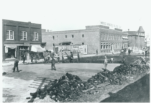Talk examines cultural funeral practices in southern Alberta
By Ry Clarke - Lethbridge Herald Local Journalism Initiative Reporter on March 29, 2023.
The Galt Museum recently hosted a discussion on the topic of funeral practices.The talk was hosted by Archives intern Avery Raine, who explored the history of funeral practices here in the city and how they have evolved over time.
Raine’s talk dissected the cultural practices seen in Lethbridge, while also exploring the “modern” practices we see today thanks to these influences.
“I’m going to be walking people through the history of funeral culture in Lethbridge, starting with Blackfoot traditions and then going into colonial traditions, ending with what we have today,” said Raine.
“A big priority for me was discussing Blackfoot practices in a way that was respectful. I am white, and I am not an authority on this culture, but I was able to consult with Camina Weasel Moccasin, our Indigenous Curator here at the museum.”
The discussion started with Blackfoot practices, looking at the different ways Indigenous peoples said goodbye.
“The Indigenous communities who lived on this land for thousands of years believed all souls after death would travel east to the Sand Hills. This was a land of sand, devoid of vegetation — the exact opposite of the abundant prairies. Also, most Abrahamic religions have this idea of moral judgments after death – Heaven or Hell or something along those lines that didn’t really exist the same in Blackfoot culture. There was no moral judgement, bodies were left in the open to allow them to find a way to the Sand Hills. If you bury the body, specifically in the soil, that would trap the spirit. Instead, platforms would be made and placed in a tree with the body on top.”
Raine also noted other practises involved stacking stones over the body, or if someone was found dead in a teepee the entrance would be covered with rocks and then over the years it would erode. “Campsites were also often abandoned after the death of someone in a tribe, avoiding the spirits,” said Raine.
Looking at the history of Lethbridge from other cultures, Raine used “Choices for the Living, Honour for the Dead,” a thesis paper by Corrine B Lenfesty from 1995.
This paper divided Lethbridge’s funeral colonial history into four categories: The Early Period (1882 to 1920), Transitional Period (1920 to 1939), Conservative Period (1939 to 1970), and the Recent Period (1970 to 1998).
“In the early 1900s, I believe it was 1904, there was a young girl, she was 11 years old, that was killed in an accident, a carriage ran her over. Her siblings had to deal with it, their mother was already dead and their dad was across the country. They tried to take her body to the railroad, but they weren’t able to take the body because they didn’t have the paperwork. So her siblings had to drive her body all the way to Lethbridge from Grassy Lake. It is so heartbreaking, but a story about love and persevering. It really sticks with me,” said Raine.
Looking at the Transitional and Conservative timeline, Raine noted how external forces play a key role towards death practices in the era.
“Advertising attitudes stopped around the mid-1930’s, no doubt due to the wider economic climate of the Great Depression,” said Raine.
“Most funeral homes during this period also expanded to include inter-denominational chapels and rooms in which you can lay out your body, due to the popularity for open caskets.”
Raine’s talk sparked interest into the history of death here exploring funerals and the culture behind the burial, offering historical insight into the modern practice we see today with various cultures and methods.
“Most of us can agree, that while funerals are for the dead, they are really about the grieving of loved ones,” said Raine.
“How a person’s life was lived, what they did, who they loved, all of that can really be gleaned and understood from the reactions to death.” 2
-1




